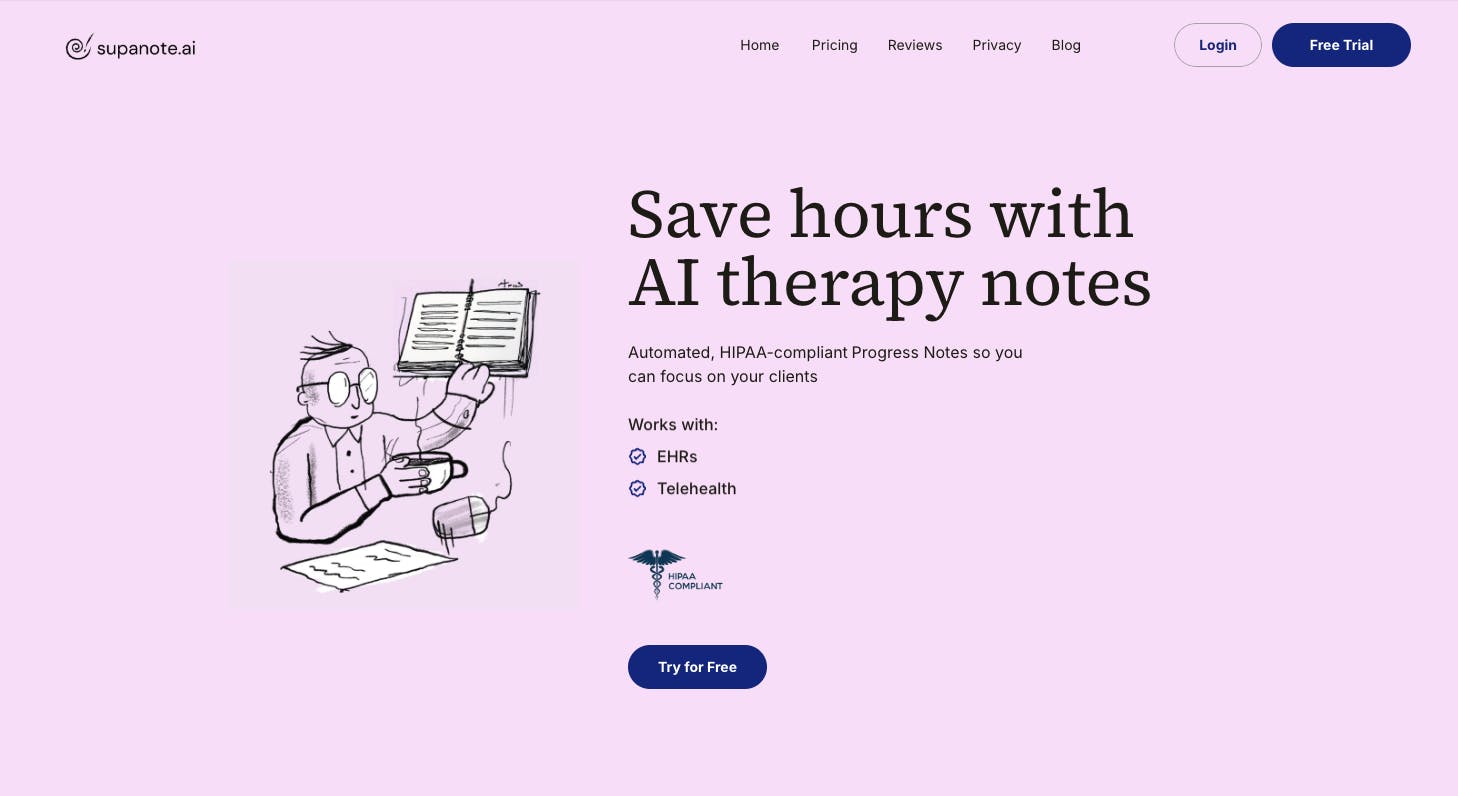If you’re spending evenings crafting detailed goals and interventions, you’re not alone. Most therapists are. Between sessions, progress notes, and admin work, treatment planning often ends up last on the list—and the one that takes the most mental energy.
Here’s the good news: tools now exist to make that part faster, easier, and still clinically sound. A treatment plan generator helps you auto-create structured, goal-oriented plans that actually make your life easier—without losing your voice or clinical reasoning.
Let’s break it down.
What Is a Treatment Plan?
A treatment plan is a written guide that outlines a client’s goals for therapy, the steps to reach them, and how progress will be tracked. It includes the diagnosis, specific objectives, chosen interventions, and a plan for review. It helps keep therapy focused, measurable, and collaborative—supporting both client outcomes and clinical documentation needs.
For example, a therapist working with a client experiencing chronic anxiety might develop goals around improving sleep, reducing daily worry, and increasing participation in meaningful activities. With clear objectives and structured interventions in place, the therapist can track progress session by session, adjust strategies as needed, and keep both the client and the treatment on course.
Sample Treatment Plan
Client: Amanda R.
DOB: 03/15/1991
Diagnosis: F33.1 – Major Depressive Disorder, recurrent, moderate
Date of Plan: 06/20/2025
Therapist: Dr. Leena K., PsyD
Session Number: 4
Service Setting: Telehealth
Presenting Problem:
Amanda reports persistent low mood, poor concentration, disrupted sleep, low energy, and decreased motivation. Symptoms have intensified over the past 3 months and are interfering with work and daily functioning.
Long-Term Goal:
To reduce depressive symptoms and increase daily functioning and emotional well-being.
Short-Term Objectives:
- Client will identify three patterns of negative self-talk using thought logs within the next two weeks.
- Client will participate in at least one enjoyable or meaningful activity weekly for the next four weeks.
- Client will complete daily mood tracking on a 0–10 scale to identify symptom trends and triggers.
- Client will implement a consistent nighttime routine at least five days per week to support improved sleep.
Planned Interventions:
- Provide CBT interventions targeting cognitive distortions and behavioral activation.
- Deliver psychoeducation around depression, thought patterns, and coping strategies.
- Support the development of a realistic activity schedule aligned with client values.
- Reinforce sleep hygiene strategies and assess adherence during sessions.
- Review thought logs and mood data in sessions to inform treatment planning.
Progress Monitoring:
Progress will be assessed through client self-report, therapist observation, and review of mood and activity logs. Plan will be formally reviewed every six sessions or as clinically indicated.
Notes:
Client remains engaged but expresses fears around failing in treatment. Therapist will continue to validate setbacks, highlight progress, and collaboratively adjust goals as needed.
What Is a Treatment Plan Generator?
A treatment plan generator is a tool designed to help mental health professionals create structured, effective treatment plans faster—with less cognitive load.
Instead of writing everything from scratch, you input basic patient information or upload a session summary, and the tool suggests measurable goals, interventions, and treatment objectives tailored to the client’s diagnosis, symptoms, and individual needs.
Behind the scenes, many of these tools use advanced AI to analyze your input and recommend clinically relevant content—rooted in real treatment planning best practices. This means fewer gaps, more organized documentation, and a clearer focus on helping your clients meet their long-term goals.
And because this process is automated, you’re not only creating better documentation—you’re doing it with improved efficiency, freeing up time to focus on what matters: patient care and outcomes.
Why Therapists Are Turning to These Tools
Therapists aren’t using treatment plan generators just because they’re trendy. They’re using them because they solve real problems in daily practice.
For starters, they save time. What used to take an hour—writing out treatment goals, matching interventions, making sure everything is measurable and clinically sound—now takes just minutes.
They also help you stay consistent. When you're juggling a full caseload, it's easy for treatment plans to vary in detail or structure. A generator gives you a reliable, structured approach that keeps your documentation aligned across clients.
Another big reason? Better focus.
With less time spent on administrative work, you can spend more time doing the actual therapy—checking in on patient progress, adjusting plans as needed, and being more present in sessions.
And let’s not forget compliance. Many generators are built with healthcare providers in mind, meaning they guide you toward the right level of detail, helping you meet documentation standards without second-guessing your notes.
In short: this isn’t about replacing your clinical thinking. It’s about giving you a system that supports it—so you can show up fully for your clients, without burning out.
What to Look for in a Good Generator
Not all treatment plan generators are created equal. If you’re choosing one for your practice, here’s what actually matters:
1. Customization
You need flexibility. A good generator should let you tailor goals, objectives, and interventions to match the client’s unique needs—not box you into generic plans.
2. SMART Goals
Look for a tool that guides you to write clear, measurable goals. This makes progress easier to track and keeps your plans useful during reviews, audits, and supervision.
3. Built-In Clinical Language
The best systems come preloaded with clinically appropriate phrasing, making it faster to draft treatment plans that sound professional—and reflect your intent accurately.
4. Editable, Not Rigid
You should always be able to adjust and refine the plan. AI suggestions are helpful, but the final plan should still sound like you.
5. Compliance and Privacy
Choose a generator that’s built for healthcare providers and mental health professionals—HIPAA compliance is a non-negotiable. So is secure handling of patient information.
6. Easy to Review and Revise
You’ll often need to update treatment objectives as the patient makes progress or shifts focus. A good tool makes it easy to organize, edit, and track those changes over time.
7. Real-World Relevance
Your generator should support a range of needs—from managing anxiety and insomnia to helping clients challenge negative thoughts or develop long-term goals.
Bottom line? The best tool doesn’t just help you write—it helps you think more clearly, document more effectively, and deliver better care.
How to Use Supanote as a Treatment Plan Generator
If you’re spending too much time on progress notes, Supanote can help you turn those notes into treatment plans—fast. Here’s how therapists are using it to simplify planning and documentation:
1. Record or upload your session
Start by uploading a voice recording or dictating a quick session summary. Supanote transcribes it securely and pulls out key clinical details—diagnosis, symptoms, focus areas, and therapeutic themes.
2. Let the AI do a first pass
Supanote’s analyzes the session using AI trained on therapy-specific language. It generates a draft plan with suggested goals, objectives, and interventions. These are designed to match real-world clinical language, not robotic templates.
3. Review and edit
You can tweak the wording, adjust treatment objectives, and reframe long-term goals based on any additional info you know about the client. It’s fast but still feels like your work.
4. Export or sync
Once you’re happy with the plan, you can export it or copy it directly into your EHR. Supanote keeps everything organized so you can review and revise it later as your client makes progress.
5. Revisit when needed
Because everything is stored in one place, updating treatment plans is easy. You can pull up the last version, make changes, and track progress without starting over.
It’s built for busy therapists—designed to support your clinical reasoning, not replace it.
Top 5 Treatment Plan Generators Therapists Are Using
If you’re exploring your options, here are five tools that therapists consistently recommend—each with its own strengths depending on your workflow and needs:
1. Supanote

Best for: Therapists who want everything in one place—notes, plans, and templates
Supanote turns your session recordings into both progress notes and personalized treatment plans. It pulls key patient information, suggests measurable goals, and auto-fills relevant interventions—all while keeping your voice and formatting preferences intact. It’s HIPAA-compliant, works with EHRs, and is designed specifically for mental health professionals.
Why therapists love it:
- Fast and simple interface
- Smart, editable suggestions
- Privacy-first design
Try Supanote for free
Automated, HIPAA-compliant Progress Notes so you can focus on your clients
Get Started Now!
2. ICANotes
Best for: Practices already using a full-featured EHR
ICANotes is known for its structured clinical documentation and built-in templates. It helps generate plans quickly with drop-downs and pre-written goals. It’s more rigid than AI-driven tools but reliable for standard documentation.
3. TherapyNotes
Best for: Clinicians who want templates inside their EHR
TherapyNotes includes treatment plan templates built into its platform. You select goals, set objectives, and customize interventions. It’s ideal if you already use their scheduling and billing system.
4. Carepatron
Best for: Solo providers looking for flexibility
Carepatron is a newer platform that offers free treatment planning content, along with client notes, task management, and telehealth tools. It includes customizable templates and collaborative features.
5. Quenza
Best for: Coaches and therapists focused on client engagement
While Quenza leans more toward homework assignments and client exercises, it includes modules to create comprehensive treatment plans. Great for goal tracking and sending progress activities to clients.
Avoid These Common Mistakes When Using a Treatment Plan Generator

Using a treatment plan generator can save you time—but only if you use it well. Here are the most common mistakes therapists make when relying on these tools, and how to avoid them:
1. Copy-pasting without thinking
It’s tempting to accept the first plan the system gives you. But templates and AI suggestions are just a starting point. Always review and adapt the language to reflect your clinical judgment and your client’s specific needs.
2. Overloading the plan
You don’t need to include everything at once. A good treatment plan focuses on what’s most relevant right now. You can always revise as the client progresses.
3. Ignoring compliance or privacy
Make sure the tool you’re using is HIPAA-compliant and secure. Never upload sensitive session content into a tool that doesn’t protect patient information. Supanote, for example, deletes audio after transcription and removes personally identifiable details from notes.
4. Relying too heavily on automation
Generators can assist you—but they’re not a replacement for clinical reasoning. You still need to evaluate, adjust, and use your professional judgment to create effective, relevant, and ethical plans.
Frequently Asked Questions
Q: Will insurance accept a plan made with a treatment plan generator?
A: Yes—as long as the plan is clinically sound, personalized, and reviewed by you. Tools like Supanote provide a strong starting point, but you remain responsible for the final content.
Q: Can I edit the generated treatment plans?
A: Absolutely. You should. The best generators give you full control to tweak goals, interventions, and wording to match your clinical intent and your client’s needs.
Q: Is Supanote HIPAA-compliant?
A: Yes. Supanote is built for mental health professionals and complies with HIPAA and GDPR. Audio files are deleted after transcription, and no identifiable information is stored in the final notes.
Q: Can I use Supanote alongside my EHR?
A: Yes. Supanote is EHR-friendly. You can copy treatment plans directly or export them for upload into most clinical documentation systems.
Q: Does it work with different modalities (CBT, EMDR, etc.)?
A: Yes. Supanote supports a wide range of formats and therapeutic approaches. You can adjust goals and interventions to align with your modality and treatment focus.
Q: How often should I update a treatment plan?
A: It depends on your setting, but generally every 6–8 sessions or whenever there’s a significant change in goals, symptoms, or interventions. Supanote makes this process quick and simple.
Q: What if I work with complex or trauma-focused clients?
A: You can still use a generator—just make sure to slow down and individualize the plan. Supanote lets you revise everything, so your treatment planning can stay client-centered and clinically appropriate.
